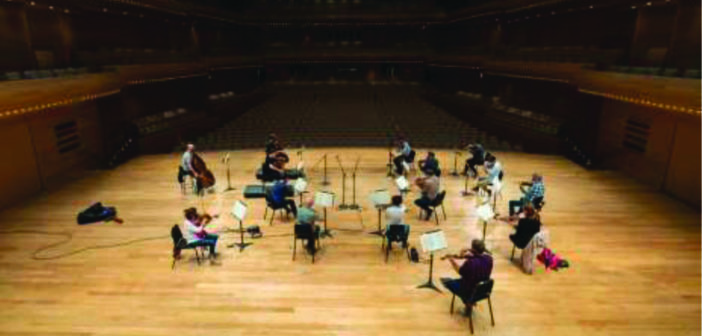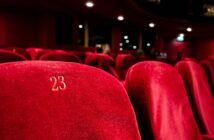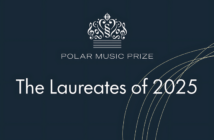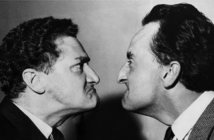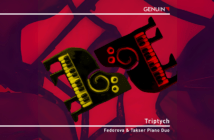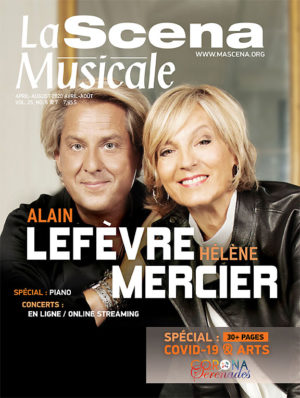
This page is also available in / Cette page est également disponible en:
![]() Francais (French)
Francais (French)
The COVID-19 pandemic has hit the cultural community hard and new health standards are emerging. The Commission des normes, de l’équité, de la santé et de la sécurité du travail (CNESST) has released a guide for employers and workers in the audiovisual production sector. This guide also applies to the entertainment industry, the performing arts, musical institutions and, in particular, musicians. According to this document, the employer has an obligation to protect the health and ensure the safety and physical integrity of workers, including artists. This allows activities to resume or continue under the safest and healthiest conditions.
If the risks of contagion cannot be eliminated, the employer must endeavour to reduce and control them, in particular by determining the tasks during which workers may be exposed to the virus. In addition, the guide lists a series of preventive measures based on several principles already in force in shops and public places: exclusion of symptomatic people from the workplace, physical distancing, respiratory etiquette, hand hygiene as well as the cleaning of tools, equipment and surfaces frequently affected.
Here is what we can take away from the main recommendations as they relate to musicians.
Work organization
The number of workers present at the same time and the number of job rotations should be reduced as much as possible. The number of trips from one place to another during the same day must be limited to what is strictly necessary (e.g. from one rehearsal room to another in the same building). Activity zones should be specifically reserved for producers and different groups of workers and artists in order to limit contact. Changes to the schedules of activities are also to be expected, as they allow the contact to be reduced effectively. Finally, a mouth-and-nose mask and eye protection (protective glasses or visor covering the face up to the chin) will be provided to producers, workers and artists who perform a task requiring them to be less than two metres from another person in the absence of physical barriers.
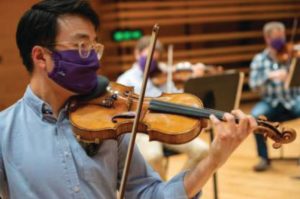 Measures for hygiene
Measures for hygiene
It is recommended that the renter of a rehearsal or concert hall be informed of the date of the last rental. It is preferable to maintain a 24-hour delay between each group of musicians. If this is not possible, surfaces likely to be touched by different people must be cleaned and disinfected before the site is used. Likewise, the sets, equipment, tools and accessories used during a rehearsal or concert must be cleaned and disinfected before and after use.
Measures for transport vehicles
Producers, workers or artists in the vehicle must be separated by a physical barrier or be seated alone or with free space between them in order to respect the distance of two metres. A mask and eye protection will be provided to the driver, producers, workers and artists when it is impossible to be at least two metres from another person without a physical barrier. In addition, the vehicle must be filled to only 50% of its capacity.
Measures for sound recording studios
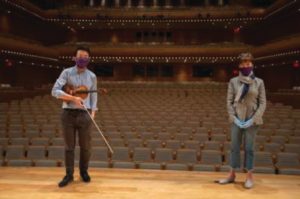 The same conditions of hygiene and organization apply in a recording studio. Note that wind instrumentalists are now affected by a special measure which stipulates that only one artist at a time, playing this type of instrument, is authorized in the recording room, unless they are separated by physical barriers (solid partitions). After an artist plays a wind instrument, the floor in their work area needs to be cleaned.
The same conditions of hygiene and organization apply in a recording studio. Note that wind instrumentalists are now affected by a special measure which stipulates that only one artist at a time, playing this type of instrument, is authorized in the recording room, unless they are separated by physical barriers (solid partitions). After an artist plays a wind instrument, the floor in their work area needs to be cleaned.
Hand hygiene
The CNESTT guide reminds artists of the rules governing hand hygiene: wash your hands often with soap and water or with an alcoholic solution of at least 60% for at least 20 seconds, especially before touching your face (eyes, nose, mouth), after coughing, sneezing or blowing your nose, when entering and leaving the premises and, as far as possible, after each use of shared equipment (chairs, lecterns , etc.).
Legal obligations of the employer and the artist
As stipulated by the CNESST, the employer has the obligation to protect the health and guarantee the safety and physical integrity of workers. In the context of COVID-19, the employer must inform them of the risks linked to their work, including those linked to the virus. He must also provide them with appropriate training and supervision so that everyone has the skills and knowledge required to perform a job safely.
As for workers, they are obliged to take measures to protect their health, safety and physical well-being and to take care not to endanger others in the workplace (Article 49 of the LSST). To do this, workers must comply with the rules and measures in effect in the context of COVID-19, just like the other rules applied in the workplace. They must also help identify and eliminate risks and, if necessary, refer them to his or her superior or to an employer representative.
Source : www.cnesst.gouv.qc.ca
This page is also available in / Cette page est également disponible en:
![]() Francais (French)
Francais (French)

